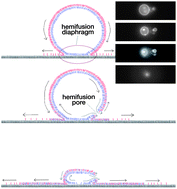Hemifusion of giant unilamellar vesicles with planar hydrophobic surfaces: a fluorescence microscopy study†
Abstract
Vesicle adhesion and fusion to interfaces are frequently used for the construction of biomimetic surfaces in biosensors and

* Corresponding authors
a Department of Physics, Carnegie Mellon University, 5000 Forbes Avenue, Pittsburgh, PA 15213-3890, USA
b Ray and Stephanie Lane Center for Computational Biology, Carnegie Mellon University, 5000 Forbes Avenue, Pittsburgh, PA 15213-3890, USA
c Department of Biological Sciences, Carnegie Mellon University, 5000 Forbes Avenue, Pittsburgh, PA 15213-3890, USA
d
Department of Biomedical Engineering, Carnegie Mellon University, 5000 Forbes Avenue, Pittsburgh, PA 15213-3890, USA
E-mail:
quench@cmu.edu
e National Institute of Standards and Technology, Center for Neutron Research, Gaithersburg, MD 20899-6102, USA
Vesicle adhesion and fusion to interfaces are frequently used for the construction of biomimetic surfaces in biosensors and

 Please wait while we load your content...
Something went wrong. Try again?
Please wait while we load your content...
Something went wrong. Try again?
G. H. Zan, C. Tan, M. Deserno, F. Lanni and M. Lösche, Soft Matter, 2012, 8, 10877 DOI: 10.1039/C2SM25702E
To request permission to reproduce material from this article, please go to the Copyright Clearance Center request page.
If you are an author contributing to an RSC publication, you do not need to request permission provided correct acknowledgement is given.
If you are the author of this article, you do not need to request permission to reproduce figures and diagrams provided correct acknowledgement is given. If you want to reproduce the whole article in a third-party publication (excluding your thesis/dissertation for which permission is not required) please go to the Copyright Clearance Center request page.
Read more about how to correctly acknowledge RSC content.
 Fetching data from CrossRef.
Fetching data from CrossRef.
This may take some time to load.
Loading related content
